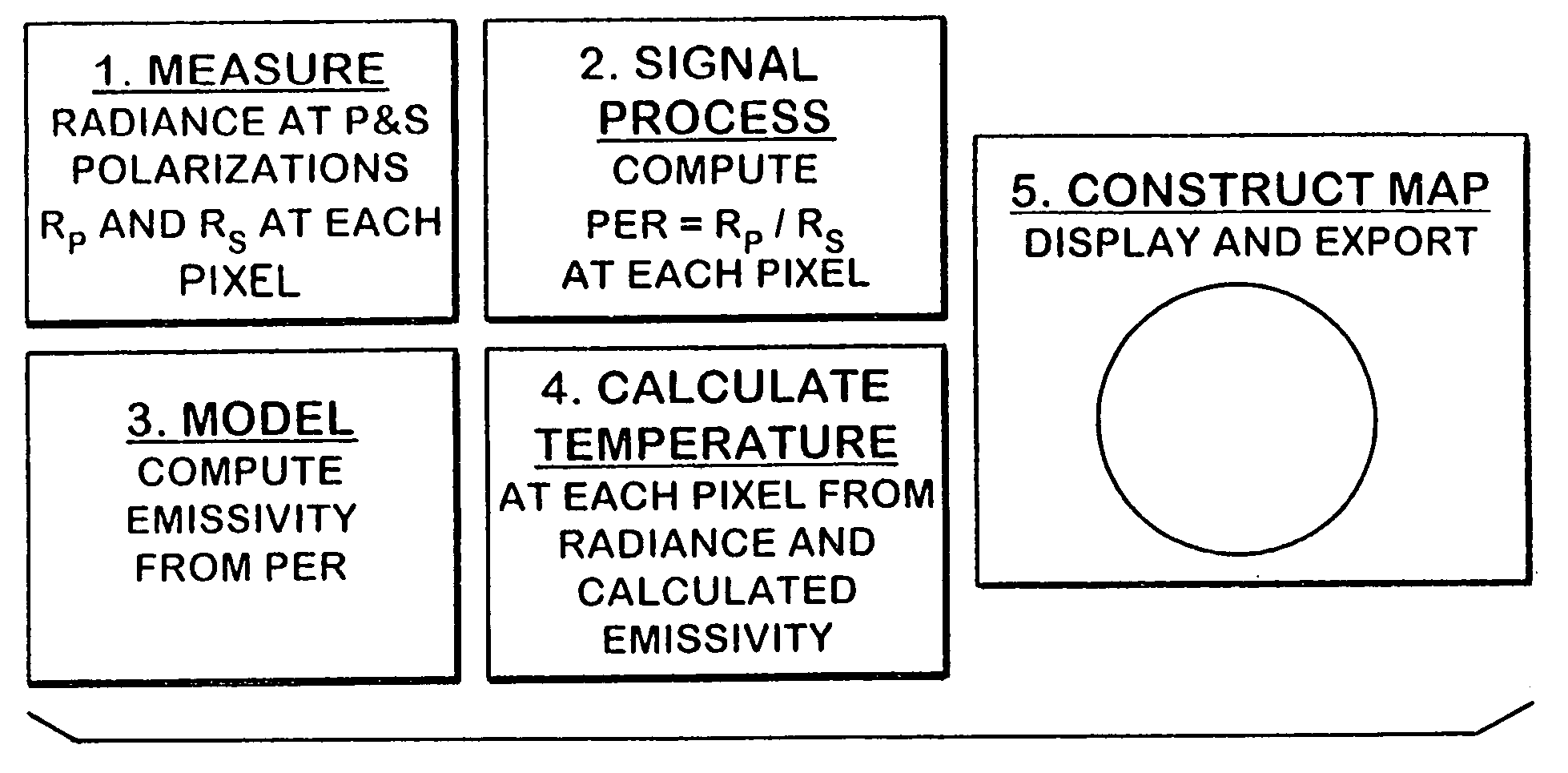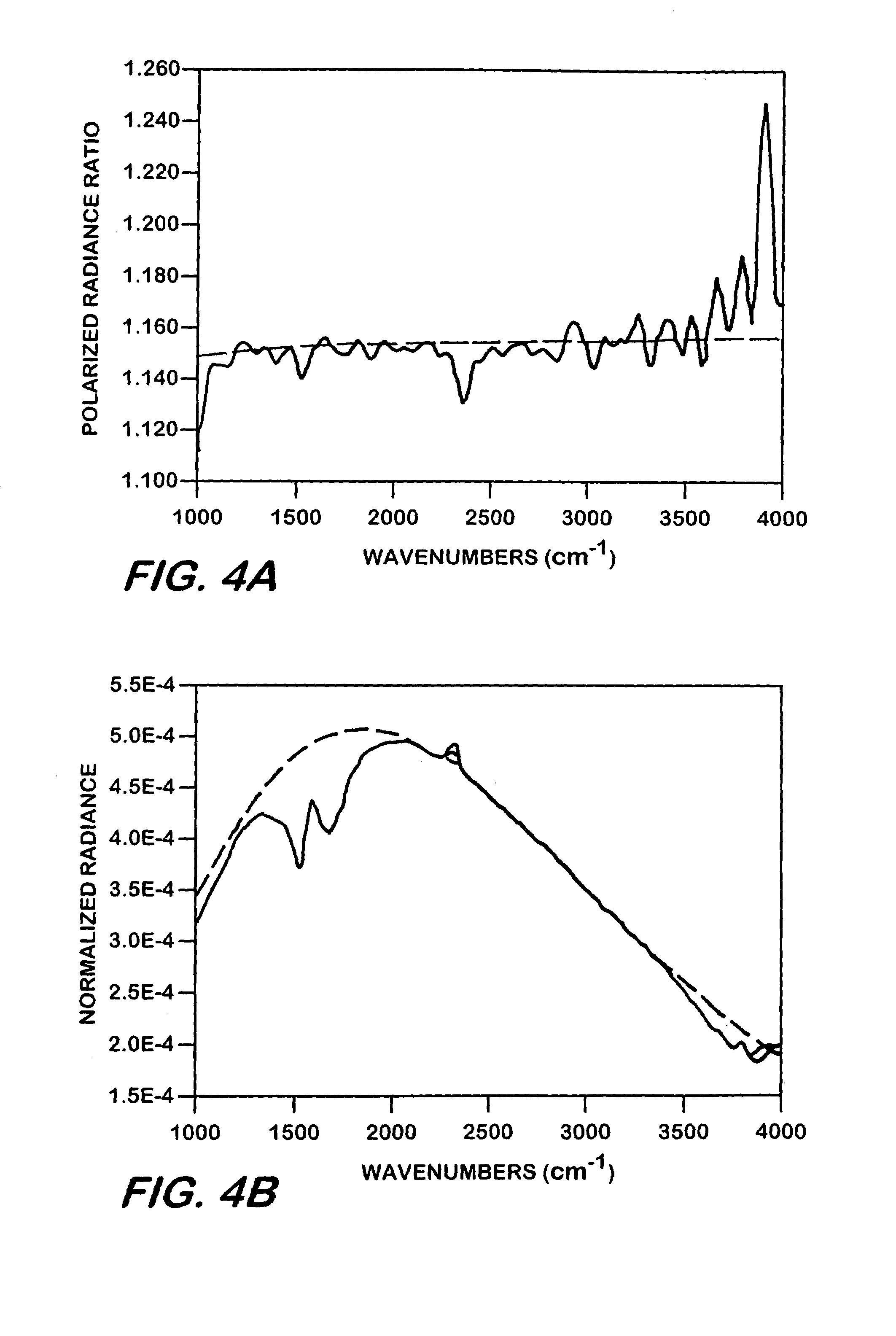Thermal imaging for semiconductor process monitoring
a technology for semiconductor process monitoring and thermal imaging, applied in the direction of heat measurement, optical radiation measurement, instruments, etc., can solve the problems of process yield limitations, inability to control process conditions adequately, and pyrometry suffers from two significant practical limitations
- Summary
- Abstract
- Description
- Claims
- Application Information
AI Technical Summary
Problems solved by technology
Method used
Image
Examples
example one
[0037]A bare, polished, lightly doped silicon substrate, at approximately 750° C., is used for making measurements of polarized radiance, augmented by model-based analysis. At the specified temperature, the free carrier absorption is strong enough to render the wafer opaque through most of the mid infrared band, but the absorption index k is small enough that it has a negligible effect on the reflectance and emissivity; a similar situation occurs for germanium and many other semiconductors. The polarized emissivity ratio in this case is given by:
[0038]εpεs=1-ρp1-ρs=1-(ncos(θ)-1-sin2(θ) / n2ncos(θ)+1-sin2(θ) / n2)21-(cos(θ)-n2-sin2(θ)cos(θ)+n2-sin2(θ))2.Equation5
From a measurement of the PER, the index of refraction of the substrate is uniquely determined and can be computed numerically using Equation 5. With the index of refraction of the substrate calculated from Equation 5, the emissivities in the two orthogonal polarizations can be computed, and the radiance can be re...
example two
[0042]As a second example, it is demonstrated that the instant method can be generalized to more complex situations, including samples with overlayers. Taking, in this instance, a hot silicon wafer carrying thin silicon dioxide film, the polarized radiance ratio, measured with an FT-IR at a take-off angle of 30°, is shown in FIG. 5(a). This spectrum was fit to a model in which the silicon oxide thickness was varied, and the optical constants of the silicon and silicon oxide were approximated by their room temperature values. FIG. 5(a) also shows the overlayed fit. The thickness was determined from the fit to be given by 0.48 micron. Using the now known thickness and the optical constants of the silicon substrate and the silicon oxide overlayer, the emissivity was calculated using a transfer matrix formalism similar to that described by Springthorpeet al. (A. J. Springthorpe, T. P. Humphreys, A Majeed, and W. T. Moore, Applied Phys. Lett. 55, (2), pp 2138–2140, 1989). The radiance sp...
example three
[0044]A third example of the method employs a sample having a non-specular surface, i.e., a sample that is relatively smooth on a macroscopic scale but rough enough to be a diffuse scatterer at infrared wavelengths, a situation that is often encountered when measuring the backsides of the single-side polished silicon wafers that are commonly employed in semiconductor manufacturing. In such a case, the sample is assumed to be specular, from the point of view of emission, with the effect of the sample roughness being largely to provide a distribution of takeoff angles from a given measurement spot. If this distribution is sufficiently narrow, as it commonly is for modern silicon wafers, then the emissivity is sufficiently well described by the average takeoff angle to provide an accurate emissivity and temperature measurement.
[0045]FIG. 6(a) shows a measurement of the polarized radiance ratio from a hot, smooth, but non-specular, silicon wafer backside at a 30° take-off angle, overlay...
PUM
| Property | Measurement | Unit |
|---|---|---|
| temperature | aaaaa | aaaaa |
| takeoff angle | aaaaa | aaaaa |
| temperature | aaaaa | aaaaa |
Abstract
Description
Claims
Application Information
 Login to View More
Login to View More - R&D
- Intellectual Property
- Life Sciences
- Materials
- Tech Scout
- Unparalleled Data Quality
- Higher Quality Content
- 60% Fewer Hallucinations
Browse by: Latest US Patents, China's latest patents, Technical Efficacy Thesaurus, Application Domain, Technology Topic, Popular Technical Reports.
© 2025 PatSnap. All rights reserved.Legal|Privacy policy|Modern Slavery Act Transparency Statement|Sitemap|About US| Contact US: help@patsnap.com



